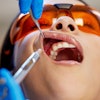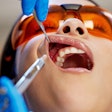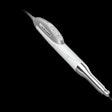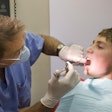
"Cavitation" is a term that is used to describe a dental problem in the jawbone. The general definition of a cavitation is an empty space formed within a solid object or body. Cavitation is not a medical term, although it is used in dentistry.
It seems to me that many patients are being diagnosed with dental cavitations in their jawbone. And of course, this could lead to an expensive surgical procedure to repair them -- sometimes critical to be done; sometimes unnecessary.
Because cavitation is not a recognized dental term or condition, there is much confusion revolving around its diagnosis and treatment. In my opinion, this is leading to misdiagnosis, overtreatment, and potential fraud by poorly qualified dentists and other healthcare professionals. I want to dive into this area and present some facts about dental cavitations.
Real thing
 Alvin Danenberg, DDS.
Alvin Danenberg, DDS.The medical term for a dental cavitation is reported in the literature as cavitational osteonecrosis or ischemic osteonecrosis. It is real. It may be a hollow space surrounded by dead bone or it may be filled with various inflammatory, toxic, and infectious elements.
Most of these lesions are painless. However, if they cause pain, they are called neuralgia-inducing cavitational osteonecrosis. But these bone lesions must be diagnosed correctly. Cavitation lesions that are only areas of demineralization with no pathology rarely need treatment.
Diagnosis and causes
To see this lesion in detail, the dentist should have the patient receive a 3D picture of the jaw. This can be done with a cone-beam CT scan of the jaw. Also, the dentist must review the dental and medical history of the patient to determine the possible causes of the bone lesion before making the diagnosis.
These lesions could be caused by a variety of insults to the bone. The following are a few of the possible causes:
- Some type of trauma to the bone causing a blockage of blood flow could cause bone cells to die, thereby creating a hollow space within the bone.
- Following an improperly performed procedure to extract a tooth could leave infection or debris in the bone socket, which could result in a dry socket and eventually a dental cavitation.
- Overheating the bone during a dental procedure using cutting drills could cause the bone to die leading to cavitational osteonecrosis.
- A tooth abscess penetrating into the bone and becoming isolated could cause the bone lesion.
- Continuing infection at the base of a failing endodontically treated tooth could be the culprit.
Treatment
It is important to realize that pain and chronic disease could occur a distance from the dental cavitation lesion. This is another reason why it may be difficult to connect the dental lesion to an area of pain and chronic disease somewhere else in the body.
“These lesions could be caused by a variety of insults to the bone.”
Treatment of cavitational osteonecrosis consists of entering the lesion and cleaning it out thoroughly. The fluid and tissues removed from the lesion should be sent to pathology for identification. The dental surgeon may use a laser to decontaminate and debride the lesion. He or she may place a biologically active material into the lesion space to enhance bone healing.
In addition to surgically treating the bone lesion, it is important to support the patient's immune system. There should be an integrative approach including a noninflammatory nutrient-dense diet and various spore-based probiotics to support a diverse and abundant garden of healthy microbes in the gut. Sometimes it will be necessary to determine if any toxic substances already exist in the body like heavy metals, which may need to be reduced or eliminated.
It is important to remember that various diseases and pain can manifest in other areas of the body than the jawbone. The medical literature needs more documented cases from researchers to wake up the healthcare professionals who are the ones to treat this problem.
Alvin Danenberg, DDS, has retired from the private practice of periodontics in Bluffton, SC. He continues to be on the faculty of the College of Integrative Medicine and created its integrative periodontal teaching module. He also spent two years as chief of periodontics at Charleston Air Force Base earlier in his career. His website is drdanenberg.com.
The comments and observations expressed herein do not necessarily reflect the opinions of DrBicuspid.com, nor should they be construed as an endorsement or admonishment of any particular idea, vendor, or organization.



















